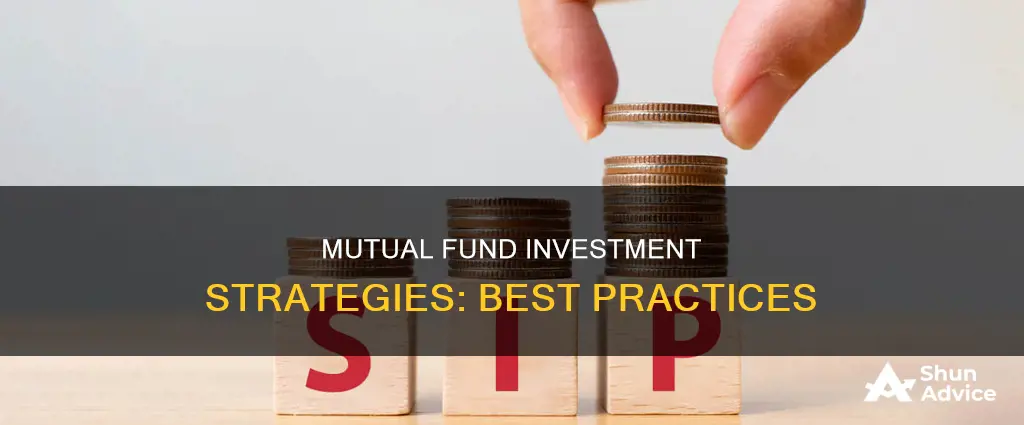
Investing in mutual funds is a great way to build a diversified portfolio without the hassle and high costs of managing individual stocks and bonds. Mutual funds are investment vehicles that pool money from multiple investors to purchase a wide range of securities, such as stocks, bonds, commodities, and other assets.
1. Set Clear Investment Goals: Determine your financial objectives, risk tolerance, and time horizon. Are you investing for the long term, such as retirement, or shorter-term goals like buying a home? This will influence the types of mutual funds you choose.
2. Choose the Right Mutual Fund Strategy: Decide between active and passive mutual funds. Active funds are managed by professionals aiming to beat the market, while passive funds aim to replicate the performance of a market index, usually with lower fees.
3. Research and Compare Mutual Funds: Look at factors such as past performance, expense ratios, load fees, and management style. Use tools like Mutual Fund Observer and Maxfunds, or research through brokerage platforms.
4. Open an Investment Account: You can invest in mutual funds through an employer-sponsored retirement plan, such as a 401(k), or open your own brokerage account if you're investing outside of retirement.
5. Purchase Shares of Mutual Funds: Ensure you have sufficient funds in your investment account. Mutual funds often have higher investment minimums than other asset classes. You can buy mutual funds through online brokers or directly from the fund manager.
6. Set Up a Regular Investment Plan: Consider setting up recurring investments to grow your wealth over time. This approach, known as dollar-cost averaging, helps reduce the impact of market volatility on your investment.
7. Monitor and Rebalance Your Portfolio: Check in on your mutual fund investments periodically to ensure they align with your financial goals and risk tolerance. Rebalance your portfolio at least once a year to maintain your desired asset allocation.
8. Understand the Fees: Mutual funds come with various fees, including expense ratios, sales loads, redemption fees, and account maintenance fees. These fees can eat into your returns over time, so be sure to read the fund's prospectus carefully.
9. Know Your Exit Strategy: Eventually, you'll want to sell your mutual fund shares to meet your financial goals or adjust your portfolio. Be mindful of any redemption fees or tax implications when selling your mutual fund holdings.
| Characteristics | Values |
|---|---|
| Investment goals | Long-term goals such as retirement or education, or short-term goals such as buying a home or a car |
| Investment strategy | Active or passive |
| Investment type | Stock, bond, money market, target-date, balanced, index, income, international, regional, sector and theme, socially responsible, etc. |
| Investment research | Use tools like Mutual Fund Observer and Maxfunds, or research through brokerages' websites |
| Investment account | Individual retirement accounts (IRAs), taxable brokerage accounts, education savings accounts, etc. |
| Investment minimums | Mutual funds may have higher investment minimums than other asset classes |
| Investment timing | Set up a plan to keep investing regularly, e.g. daily, weekly or monthly |
| Investment fees | Expense ratios, load fees, management fees, 12b-1 fees, redemption fees, account fees, etc. |
| Investment returns | Dividend/interest income, portfolio distributions, capital gains distribution |
| Investment risks | Market risk, interest rate risk, management risk, etc. |
What You'll Learn

Active vs passive funds
When it comes to investing in mutual funds, one of the first decisions you'll need to make is whether to opt for active or passive funds. Here's a detailed breakdown of the differences between the two to help you make an informed choice:
Active Funds:
Active funds are managed by professional investors with the goal of outperforming a market index, such as the S&P 500. These funds involve a team of analysts who conduct extensive research and analysis to identify which stocks or investments to buy, sell, or hold to achieve the best returns. Active fund managers aim to beat the market through their expertise and quick response to market changes. However, this hands-on approach comes at a cost, as active funds typically charge higher fees to cover the expenses of professional management.
Passive Funds:
Passive funds, on the other hand, are designed to track the performance of a market index. Unlike active funds, they don't require an expensive investment team because they are not trying to pick the best-performing stocks. Instead, they aim to mirror the index's performance. This approach allows passive funds to charge very low fees or sometimes no fees at all, which translates into higher returns for investors. Passive funds are often seen as a simpler and more cost-effective option for those who want a more hands-off approach to investing.
Performance Comparison:
While active funds aim to beat the market, they often fall short of this goal. Historical data shows that passive funds have consistently outperformed active funds over long periods. Passive funds benefit from lower fees, which can compound over time, resulting in higher overall returns. However, it's worth noting that during short-term periods, some active funds may outperform their passive counterparts.
Risk and Flexibility:
Active funds offer more flexibility as they are not restricted to a specific index. Active managers can identify and invest in unique opportunities, hedge their bets using various techniques, and exit specific stocks or sectors when the risks become too high. On the other hand, passive funds are limited to the holdings of the index they track, providing less flexibility but also reducing the risk of human error in decision-making.
Suitability:
The suitability of active vs. passive funds depends on your investment goals, risk tolerance, and level of involvement. Active funds may be more suitable for investors who want to take a hands-on approach, have the time and expertise to research and monitor their investments, and are willing to pay higher fees for the potential of higher returns. Passive funds, on the other hand, are often recommended for investors seeking a more passive, long-term investment strategy with lower fees and a more straightforward approach.
Combining Strategies:
It's important to note that active and passive investing are not mutually exclusive. Many investment advisors advocate for a blended approach, utilizing the strengths of both strategies to further diversify a portfolio and manage risk. This blended strategy can be useful for investors with different goals and risk tolerances, allowing them to take advantage of the benefits of both active and passive fund management.
Mid-Cap Funds: Smart Investment for Long-Term Growth
You may want to see also

Investment goals
Before investing in any fund, you must first identify your goals for the investment. Is your objective long-term capital gains, or is current income more important? Will the money be used to pay for college expenses, or to fund a retirement that's decades away?
If you're investing for the short-term, you should skip stock and bond mutual funds. Stocks and bonds offer hard-to-beat long-term returns, but they can be volatile. If you're building up your emergency fund or saving for a short-term goal like a wedding or vacation, you may want to opt for a short-term vehicle like a savings account or money-market fund.
If you're investing for the long-term, your portfolio will be able to weather the stock market's periodic losses. With a longer time frame, you can afford to take on more risk and aim for higher returns.
If you're saving for a goal that's decades away, like retirement, stock mutual funds are a great choice. You've got plenty of time to ride out the inevitable ups and downs of the stock market. While no investment guarantees a return, mutual funds are safer than some other options because you're invested in a broad range of companies or debts.
If you're saving for a goal that's only a few years away, a bond market mutual fund might be a better option. These funds invest in a range of bonds and provide a more stable rate of return than stock funds.
If you're saving for a goal that's only a few years away and need easy access to your money, consider a high-yield savings account. These accounts provide greater liquidity and are federally insured up to at least $250,000.
Once you've identified your mutual fund investing goals, you can pick funds with the right investment strategy. If you're investing for the long-term, your mutual fund allocation should probably be 70% to 100% in stock-based mutual funds to position yourself for the most investment growth. If investing heavily in stocks makes you nervous, you may want to opt for a balanced mutual fund, which invests in both bonds and stocks to offset some of the risk associated with stocks.
If you're investing for the mid-term, you may want to consider a balanced mutual fund that invests in both stocks and bonds. This will reduce the potential for rapid changes in investment value.
If you're investing for the near-term, your focus should be on minimizing risk. You might aim to invest 30% in stock mutual funds and the rest in bond funds. The bond funds will produce a steady income through interest payments while the limited stock component may allow you to see some investment growth.
If you'd prefer to avoid the hassle of picking a portfolio allocation, consider investing in a target-date fund. These funds target a specific year in the future when the investor needs to withdraw their funds and provide a complete, well-diversified allocation of equity and bond holdings. The further from that date, the more the fund invests in riskier assets like stocks. As the target date approaches, the fund gradually adjusts its holdings to lower-risk assets.
A Guide to Investing in Vanguard Funds from South Africa
You may want to see also

Mutual fund fees
Mutual funds charge fees for various costs, including operating expenses, marketing, and selling the fund. These fees can significantly impact your overall returns, so it's important to understand them before investing. Here are some common types of mutual fund fees:
- Expense ratio: This is an annual fee that covers the fund's operating expenses, including management fees, administrative costs, and marketing expenses. It is expressed as a percentage of the fund's average net assets and is deducted from the fund's returns. The expense ratio has decreased significantly over the years due to competition from index investing and exchange-traded funds (ETFs).
- Sales charges or loads: Some mutual funds charge sales fees, known as "loads," when you buy or sell shares. Front-end loads are charged when you purchase shares, while back-end loads are assessed if you sell your shares before a certain date. No-load funds, on the other hand, don't charge any sales commissions.
- Redemption fees: Some mutual funds charge a fee when you sell your shares within a short period (usually 30 to 180 days after purchasing them. This fee is designed to discourage short-term trading and maintain stability.
- Other account fees: Some funds or brokerage firms may charge additional fees for maintaining your account or transactions, especially if your balance falls below a certain minimum.
- Management fees: These fees cover the cost of the fund's managers and investment advisors.
- 12b-1 fees: These fees cover the costs of marketing and selling the fund.
- Front-end and back-end loads: Front-end loads are sales commissions charged when you buy shares, while back-end loads are charged when you sell your shares.
It's important to carefully review the fund's prospectus to understand all the fees associated with a particular mutual fund. Additionally, you can often avoid brokerage fees and commissions by purchasing a fund directly from the mutual fund company instead of through an intermediary.
Index Funds in Australia: Best Investment Options
You may want to see also

Mutual fund types
There are several types of mutual funds, each with its own unique characteristics, catering to different investor needs, goals, and risk tolerances. Here is an overview of some common types:
- Equity Mutual Funds: These funds invest primarily in stocks and aim for high returns by capitalising on the growth potential of companies. They are suitable for investors with a higher risk tolerance and a long-term investment horizon (typically five to seven years or more). Examples include large-cap, mid-cap, and small-cap funds, which focus on companies with different market capitalisations.
- Debt Mutual Funds: Debt funds invest in fixed-income instruments, such as bonds, and aim to provide stable returns with lower risk. They are suitable for conservative investors or those nearing financial goals, with a shorter investment horizon of around one to three years.
- Hybrid Mutual Funds: Hybrid funds combine investments in both equity and debt instruments, offering a balanced approach. They are designed for investors seeking growth potential while also wanting the stability of debt investments. Examples include conservative hybrid funds, which allocate a larger portion to debt, and balanced hybrid funds, which maintain a more equal ratio between equity and debt.
- Solution-Oriented Mutual Funds: These funds are tailored for specific financial goals, such as retirement planning or children's education, and usually have a long-term investment horizon and a lock-in period. They may invest in a mix of equity and debt, depending on the goal's time horizon.
- Index Mutual Funds: Index funds are passively managed, meaning they track a specific market index (e.g. S&P 500) and aim to replicate its performance. They are suitable for investors seeking a low-cost, passive investment strategy with lower management fees.
- Asset Allocation Funds: These funds allow investors to diversify across multiple asset classes, such as stocks, bonds, and money market securities, in a single fund. The aim is to maximise returns while minimising risks.
- Alternative Funds: Alternative funds invest in non-traditional assets, such as hedge funds, real estate, commodities, and derivatives contracts. They offer returns that are generally less correlated with standard asset classes.
When choosing a mutual fund type, it's essential to consider your risk tolerance, investment goals, time horizon, and diversification needs. Additionally, understanding the fees and expense ratios associated with each fund is crucial, as these can significantly impact your overall returns.
Hedge Fund Memos: Where to Access and Read
You may want to see also

How to buy mutual funds
There are several steps to buying mutual funds. Here is a detailed, step-by-step guide:
- Decide on your investment goals: Are you investing for the long term, such as for retirement, or the short term, such as for a home or car? This will determine the type of mutual fund you should choose.
- Pick your mutual fund strategy: If you are investing for the long term, you will probably want to allocate 70% to 100% of your portfolio to stock-based mutual funds. If you are investing for the medium term, you might want to choose a balanced fund, which invests in both bonds and stocks. If your goal is in the near term, you might want to invest 30% in stock mutual funds and the rest in bond funds.
- Research potential mutual funds: Use tools like Mutual Fund Observer and Maxfunds to research different mutual funds. Consider factors such as past performance, expense ratios, load fees, and management style (active or passive).
- Open an investment account: You may already have access to mutual funds through an employer-sponsored retirement plan. If not, you can open a brokerage account and invest in an individual retirement account (IRA), a taxable brokerage account, or an education savings account.
- Purchase shares of mutual funds: Make sure you have enough money deposited in your investment account to meet the minimum investment, which is typically a few thousand dollars. You can buy mutual funds through online brokers or directly from the fund manager.
- Set up a plan to keep investing regularly: Decide how much you want to invest and set up recurring investments on a daily, weekly, or monthly basis. This will help you build wealth and pay less per share over time.
- Consider your exit strategy: Remember that you will eventually want to sell your mutual fund shares to pay for your financial goals. Be aware of any fees or taxes you may owe when you cash out.
Where to buy mutual funds
You can buy mutual funds through an online broker or directly from the fund manager. If you already have an employer-sponsored retirement plan, such as a 401(k), you may already be invested in mutual funds. You can also buy mutual funds directly from the company that created the fund, such as Vanguard or BlackRock, or through a traditional financial advisor.
How to sell mutual funds
You can sell mutual funds in a similar way to how you bought them, either through an online broker or the fund manager. Remember that mutual funds are not ideal for short-term trading, as they usually have fees for selling within a short period (known as early redemption fees). They are best used as a long-term investment vehicle.
Emerging Bluechip Fund: Is Mirae Asset Worth the Investment?
You may want to see also
Frequently asked questions
There are many different types of mutual funds, but the four main categories are stock, money market, bond, and target-date funds. Stock funds invest in corporate stocks, money market funds invest in short-term debt, bond funds invest in debt securities, and target-date funds are designed for retirement savings with a specific end date in mind.
Mutual funds offer diversification, professional management, and a wide variety of investment options. They are also highly liquid and easily accessible to investors, even those with limited funds to start.
When choosing a mutual fund, consider your investment goals and time frame, asset allocation, and cost. It's important to evaluate the fund's managers, performance, and fees before investing.
You can invest in mutual funds through an online broker or directly through the fund manager. You will need a brokerage account with enough funds to purchase shares, and you may be able to set up automatic recurring investments. Remember to consider the fees associated with buying and selling mutual fund shares.







